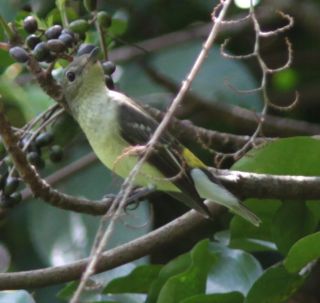This week started quite slowly, but Thursday was a very good day for numbers of different migrant species.
Egrets are now migrating past Po Toi in the early morning – mixed flocks of Little Egret, Cattle Egret and Pond Heron flying south west along the coast and the first flock of Great Egrets flying due south east towards the Philippines. A few birds from the coastal flocks sometimes drop off on Po Toi, this week an Intermediate Egret on Thursday was an unusual autumn record but 30 minutes later a Purple Heron flew around the harbour area. I don’t know if it set foot on the Island, but it doesn’t matter – it was my first record for this species, although there is already one on the Po Toi list from autumn 2005.
Here a typical mixed flock with three Little, one Cattle and four Pond Herons, the Intermediate Egret on the south coast rocks and a distant view of the Purple Heron.



The first migrant raptor arrived on Tuesday, Chinese or Japanese Sparrowhawk (see elsewhere). Also on Tuesday, an Emerald Dove and the second Forest Wagtail of the season. Emerald Dove is an annual September visitor to Po Toi, presumably dispersing birds.
The numbers of Dollarbirds grew daily to four on Thursday, together with Black-winged Cuckoo-shrike, Brown Shrike, Black-naped Oriole and a single Ashy Drongo.
Warblers and flycatchers were still in small numbers, only Arctic Warbler and three species of flycatcher, Asian Brown (at least two), Yellow-rumped (also at least two) and an Asian Paradise Flycatcher. The first Lanceolated Warbler was flushed from the South Peninsular grassland on Thursday.
Here photos of the Sparrowhawk, a Yellow-rumped Flycatcher and the Asian Paradise Flycatcher.



Finally, the White Wagtail baicalensis is still on the Island, together with the male leucopsis. Here some closer photos than those previously published.


At sea, just two Common Terns and a single second-winter Black-tailed Gull, another regular September migrant.
For the HKBWS trip on Sunday, the best areas are around the ferry pier and up to the sister’s café, and the tall trees behind the restaurant from the concrete helipad right along the beach front to the very far corner where the path goes up to the right.
One of the pleasures of staying on Po Toi is to see the night sky on clear nights, particularly in autumn. A clear night on Wednesday evening this week gave a superb view of the International Space Station passing overhead. This will be repeated on Sunday, at 18.26pm, coming from the NW and passing directly overhead to the SE. You should be able to see it from the front of the ferry just before you reach Stanley and coming from the direction of Stanley (or anywhere in Hong Kong, coming from the NW). Look for a bright light passing steadily across the sky – its not an aeroplane.
(Also tonight, Friday, at 19.07pm, same direction, passing almost overhead at 19.10pm)
[
Last edited by wgeoff at 17/09/2010 06:35 ]


